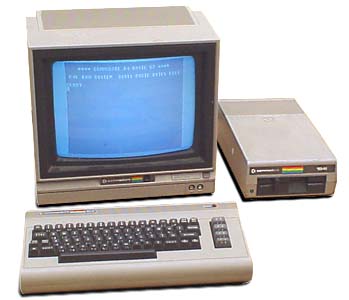History of Computers - Commodore 64
The Commodore 64 was released January, 1982 by Commodore International. [1]
Overview
The Commodore 64 contained 64 kilobytes worth of memory (hence the name), and were superior than the IBM computers of that time. It provided a new technology for the middle-class people by creative mass-production. The C64 beat out the other competition with its advanced hardware and its cheap pricing. About 10,000 software titles were made for the C64, and are still being used today by some computer hobbyists. [3] The C64 is the best-selling computer of all-time, due to its 17 million sales. [4] Though this computer just looked like a bulky keyboard, it "boasted color graphics and sophisticated sound, and excelled at playing early video games." [5] The amazing thing about the C64 is that the prototypes were made on an incredibly tight schedule of 2 months, so they could be put out at the Winter CES. The C64 ended up being the hit at the CES and had a deadline of 3 months until they were put into production to actually finalize the computers. [6]

Significance
This computer is significant because it provided new technology at low prices, and revolutionized the gaming and computer industry with its advanced hardware and demo scene. It was the first computer for the masses [7]
Specs
Internal hardware
- Microprocessor CPU:
- MOS Technology 6510 (the 6510/8500 being a modified MOS Technology 6502 with an integrated 6-bit I/O port)
- Clock speed: 1.023 MHz (NTSC) or 0.985 MHz (PAL)
- Video: MOS Technology VIC-II 6567/8567 (NTSC), 6569/8569 (PAL)
- 16 colors
- Text mode: 40×25 characters; 256 user-defined chars (8×8 pixels, or 4×8 in multicolor mode); 4-bit color RAM defines foreground color
- Bitmap modes: 320×200 (2 unique colors in each 8×8 pixel block),[8] 160×200 (3 unique colors + 1 common color in each 4×8 block)[9]
- 8 hardware sprites of 24×21 pixels (12×21 in multicolor mode)
- Smooth scrolling, raster interrupts
- Sound: MOS Technology 6581/8580 SID
- 3-channel synthesizer with programmable ADSR envelope
- 8 octaves
- 4 waveforms: triangle, sawtooth, variable pulse, noise
- Oscillator synchronization, ring modulation
- Programmable filter: high pass, low pass, band pass, notch filter
- Input/Output: Two 6526 Complex Interface Adapters
- 16 bit parallel I/O
- 8 bit serial I/O
- Time of Day clock
- 16 bit cascadable timers
- RAM:
- 64 KB (65,536 bytes), of which 38 KB minus 1 byte (38,911 bytes) were available for BASIC programs
- 512 bytes color RAM
- Expandable to 320 KB with Commodore 1764 256 KB RAM Expansion Unit (REU); although only 64 KB directly accessible; REU mostly intended for GEOS. REUs of 128 KB and 512 KB, originally designed for the C128, were also available, but required the user to buy a stronger power supply from some third party supplier; with the 1764 this was included. Creative Micro Designs also produced a 2 MB REU for the C64 and C128, called the 1750 XL. The technology actually supported up to 16 MB, but 2 MB was the biggest one officially made. Expansions of up to 16 MB were also possible via the CMD SuperCPU.
- ROM:
- 20 KB (9 KB BASIC 2.0; 7 KB KERNAL; 4 KB character generator, providing two 2 KB character sets) [10]
Links
http://en.wikipedia.org/wiki/Commodore_64
http://www.devili.iki.fi/Computers/Commodore/C64/Programmers_Reference/Chapter_3/page_123.html
http://www.devili.iki.fi/Computers/Commodore/C64/Programmers_Reference/Chapter_3/page_128.html
http://www.jeremyreimer.com/total_share.html
http://www.wired.com/culture/lifestyle/news/2003/09/60349

References
- ↑ http://en.wikipedia.org/wiki/Commodore_64
- ↑

- ↑ http://en.wikipedia.org/wiki/Commodore_64
- ↑ http://www.jeremyreimer.com/total_share.html
- ↑ http://www.wired.com/culture/lifestyle/news/2003/09/60349
- ↑ http://www.c64.com/
- ↑ http://en.wikipedia.org/wiki/Commodore_64
- ↑ http://www.devili.iki.fi/Computers/Commodore/C64/Programmers_Reference/Chapter_3/page_123.html
- ↑ http://www.devili.iki.fi/Computers/Commodore/C64/Programmers_Reference/Chapter_3/page_128.html
- ↑ http://en.wikipedia.org/wiki/Commodore_64